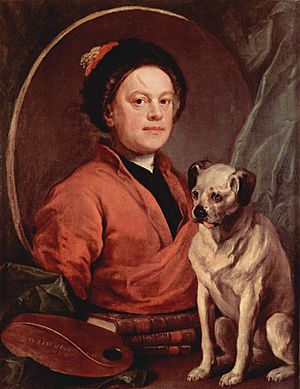The Four Stages of Cruelty facts for kids

The Four Stages of Cruelty is a set of four engravings created by the English artist William Hogarth in 1751. Each print tells a part of the life story of a made-up character named Tom Nero. The series shows how being cruel, especially to animals, can lead to a very bad path in life. Hogarth wanted to teach people about the importance of kindness and the dangers of cruelty.
Contents
Understanding 'The Four Stages of Cruelty'
This famous series of artworks was made to send a strong message. Hogarth believed that if someone was cruel to animals when they were young, it could lead them to do worse things later in life. He used the story of Tom Nero to show this idea step-by-step.
Who Was William Hogarth?
William Hogarth (1697–1764) was a very important English painter and printmaker. He was known for his "modern moral subjects," which were like stories told through pictures. He often showed the problems and issues of society in his art. Hogarth wanted his art to teach people lessons and make them think about how they behaved. He created many famous series, and The Four Stages of Cruelty is one of his most well-known works.
The Story of Tom Nero
The four prints follow Tom Nero from his childhood to his death. Each picture shows him doing something more and more cruel. Hogarth used Tom's story to warn people about the path that unkindness can lead to.
Stage One: Childhood Cruelty
The first print is called First Stage of Cruelty. It shows Tom Nero as a young boy. He is doing very unkind things to animals, like hurting a dog and throwing stones at a bird. Other children around him are also being unkind or watching without helping. This stage shows how cruelty can start small, often when people are young and don't understand the harm they are causing.
Stage Two: Cruelty's Progress
The second print, Second Stage of Cruelty, shows Tom Nero as a young man. His actions have become more serious. He is now hurting people, not just animals. This stage suggests that if cruelty is not stopped early, it can grow and lead to more harmful behavior. It shows how bad habits can get worse over time.
Stage Three: A Life of Crime
The third print is named Cruelty in Perfection. In this picture, Tom Nero has become a dangerous person. His life of cruelty has led him to commit very serious acts. This stage shows the terrible end results of a life filled with unkindness and bad choices. It is a warning about how a lack of empathy can lead to a dark path.
Stage Four: The End of Cruelty
The final print is called The Reward of Cruelty. It shows the very sad and violent end of Tom Nero's life. This last image is meant to be a strong warning. It tells viewers that a life of cruelty and crime will not end well. Hogarth wanted to show that bad actions have serious consequences.
Why Hogarth Created This Series
Hogarth was very concerned about how people treated animals and each other in his time. He believed that being kind to animals was a sign of a good person. He created The Four Stages of Cruelty to make people think about their actions. He hoped his prints would encourage kindness and discourage cruelty, especially among young people. He wanted to show that even small acts of unkindness can lead to bigger problems later on.
Impact and Legacy
When The Four Stages of Cruelty was published, it was very popular. Many people saw the prints and talked about their message. Hogarth's work helped to start conversations about animal welfare and how society should treat its members. Even today, these prints are studied for their artistic value and their powerful message about kindness and consequences. They remind us that our actions, big or small, can have a lasting impact.
See also
 In Spanish: Las cuatro etapas de la crueldad para niños
In Spanish: Las cuatro etapas de la crueldad para niños

